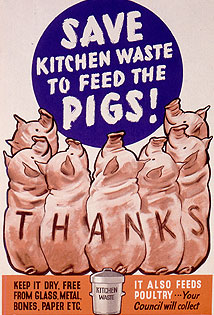
La página que intenta visitar sólo está disponible en inglés. ¡Disculpa!
The page you are about to visit is currently only available in English. Sorry!

 A World War II poster encouraging kitchen waste to feed animals. |
From farm to fork, Americans waste 40 percent of their food. In addition to the economic and ethical ramifications, our widespread squandering has far-reaching environmental impact. Since each person creates roughly a half-pound of food waste per day, we can play a significant role in reducing it. Jonathan Bloom, author of American Wasteland, shares five tips for reducing food waste in Audubon’s Special Food Issue:
Shop Smartly
Plan a week’s worth of dinners and make a detailed shopping list to prevent overbuying. Leave a few nights free for leftovers or changing plans. Stick to your list and be honest with yourself—don’t buy produce that often goes unused. (Click here for Audubon’s handy label guide, an indispensible source of info to help you decipher the environmental claims plastered on food products lining grocery store aisles.)
In Sight, All Right
Keeping food visible works wonders. That means avoiding the cluttered fridge and cabinets where items get pushed to the back. Take a tip from supermarkets: Put the newer groceries behind the older ones.
Avoid Portion Distortion
Don’t dish out too much. It’s easy to take seconds, but we don’t often save what’s left on the plate. And beware—today’s massive plates make a reasonable amount look tiny. If you’re out to eat, know that you’ll likely get more food than you need or want. If leftovers leave you cold, halve recipes and order differently at restaurants.
Love Your Leftovers
Eat your leftovers. It’s easy to keep the remains of your dinner, but that’s no help if you don’t eat them. They’re ideal lunches, and they’ll save you time and money.
Expiration Exasperation
Trust your senses before you rely on the package date. Sell-by dates are aimed at retailers and leave about a week to enjoy an item at home. And best-by is less stringent than use-by.
Click here for more delicious and informative stories from Audubon’s Special Food Issue.